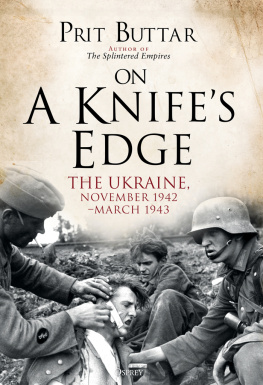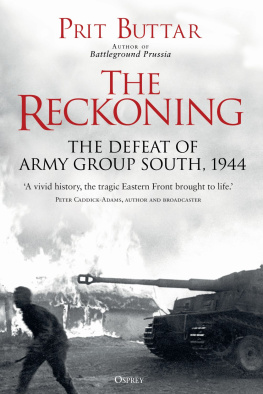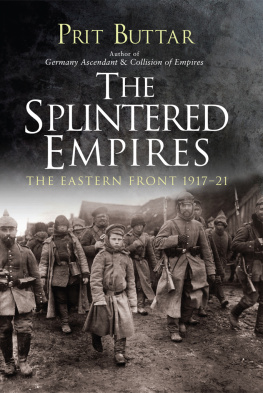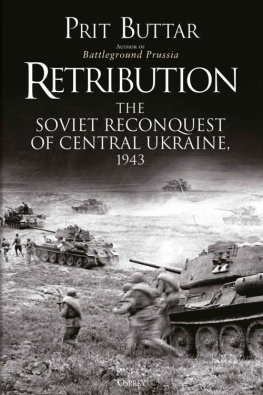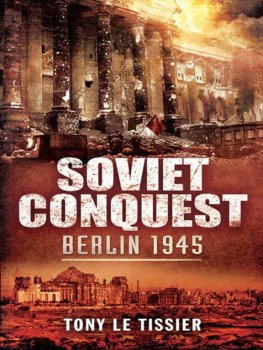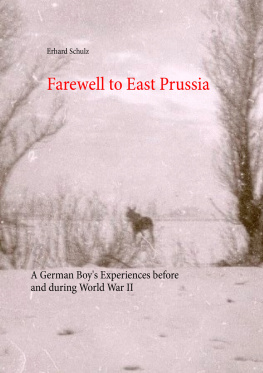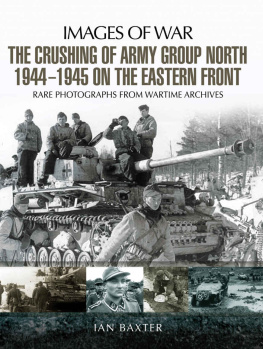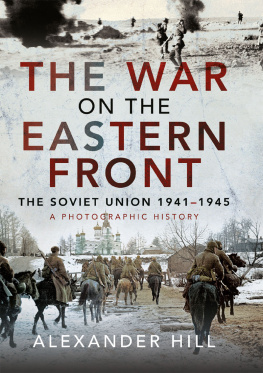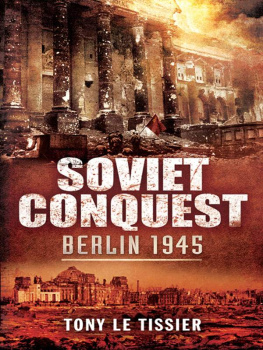THE ASSAULT ON GERMANYS EASTERN FRONT 194445
PRIT BUTTAR
CONTENTS
LIST OF ILLUSTRATIONS
BETWEEN PAGES
Dietrich von Saucken, 1943. (Topfoto)
Erich Koch. (Topfoto)
Walter Weiss (second from left) and Friedrich Hossbach (fourth from left), summer 1944. (Bundesarchiv Bild)
Karl Mauss, 1945. (Bundesarchiv Bild)
Karl Lorenz, Ukraine, 1944. (Bundesarchiv Bild)
Ivan Khristoforovich Bagramian, summer 1944. (akg-images)
Konstantin Konstantinovich Rokossovsky (left), speaking to Georgi Konstantinovich Zhukov, Poland, late 1944. (akg-images, RIA Novosti)
Members of the military council of the Third Belorussian Front, 1944. (akg-images, RIA Novosti)
The Prinz Eugen, Copenhagen harbour, 1945. (Topfoto)
The Admiral Scheer, 1945. (Bundesarchiv Bild)
The Wilhelm Gustloff, Hamburg, 1937. (akg-images)
The Steuben, 1925. (Bundearchiv Bild)
The Pz.IV tank, 1944 (akg-images, ullstein bild)
Panther tanks, December 1944. (Corbis)
The Tiger tank. (akg-images, ullstein bild)
Jg.Pz. IVs, Hungary, 1944. (Bundesarchiv Bild)
A Jagdpanther similar to the vehicle used by Bix, summer 1944. (Bundesarchiv Bild)
BETWEEN PAGES
The IS-2 tank, Berlin, 1945 (Topfoto)
The Il-2 aircraft. (Topfoto)
The Polykarpov PO-2 aircraft. (wikicommons)
The bridge at Nemmersdorf, destroyed in battle, late 1944. (Topfoto)
Two Panther tanks, Memel, December 1944. (Topfoto)
A 16-year-old is sworn into the Volkssturm, 1944. (Topfoto)
A youth and an elderly man armed with Panzerfausts, April 1945. (Topfoto)
Street fighting, Knigsberg, April 1945. (Topfoto)
Soviet artillery, Danzig, March 1945. (akg-images)
Soviet forces near Danzig, March 1945. (akg-images)
German refugees, East Prussia, early 1945. (Bundesarchiv Bild)
German refugees, Frisches Haff, February 1945. (Topfoto)
T-34 tanks, near Knigsberg, February 1945. (Topfoto)
Soviet forces, near Knigsberg, February 1945. (Topfoto)
German officers march into captivity, Knigsberg, April 1945. (Bundesarchiv Bild)
LIST OF MAPS
AUTHORS NOTE
This book was conceived from a chance conversation with an elderly lady, who told me of her life in East Prussia, and her flight from her homeland in 1945. I am indebted to Gretel Caton for introducing me to this almost forgotten episode of World War II.
The list of those who have helped me with this project is enormous. My good friend David C. Clarke was instrumental in more ways than I can list, and Tom Houlihan, John Mulholland and Euan Ferguson tirelessly read the various drafts as I produced them. Doug Nash and David Glantz encouraged me at various points along the road, for which I am grateful, as I am to Fee Rushbrooke, who gave me insights into the geography and climate of the region. Contributors to two World War II websites the Axis History Forum and Feldgrau were a constant source of information and encouragement. Amongst them, Jan-Hendrik Wendler and Michael Miller were especially generous to me on several occasions.
My agent, Robert Dudley, showed great patience in introducing me to the world of publishing, and the staff at Osprey, in particular Jaqueline Mitchell, Jon Jackson and Emily Holmes, helped me turn the original manuscript into something far more presentable.
And last but not least, my family put up with my obsession with this project for many years, and without their encouragement I would have given up long before the end.
PREFACE
Hear me more plainly.
I have in equal balance justly weighd
What wrongs our arms may do, what wrongs we suffer,
And find our griefs heavier than our offences.
William Shakespeare
This book is the story of the last months of World War II in Northeast Europe. These months saw the final death of any lingering hope that, once the war was over, the old order in the old continent would be restored. Even as one war came to an end a new Cold War began, and would dominate the world for nearly half a century. Specifically, this book describes the Soviet assault into East and West Prussia in 1944 and 1945. The fighting was as tough as any phase of the bitter conflict on the Ostfront (Eastern Front), and it changed the map of Europe forever. The campaigns resulted in one of the largest migrations of Europeans in history and, before the fighting was over, three of the five worst recorded losses of life at sea, which in themselves accounted for about 17,000 lives. And yet, in the English-speaking world, these campaigns and battles in what was northeast Germany remain comparatively unknown.
Western accounts of the last year of World War II in Europe describe momentous events: the invasion of Normandy in June 1944, and the bitter fighting that followed; the American breakout and the envelopment of thousands of German troops in the Falaise pocket; the jubilant liberation of Paris; and lower-key but nevertheless equally important moments as the German occupying forces were driven from other parts of France and Belgium. After the bloody failure of the Western Allies to secure a bridgehead across the Rhine at Arnhem, the narrative passes to the final German offensive in the Ardennes. Thereafter, the tale is one of an unbroken series of Allied victories the crossing of the Rhine, the envelopment of the Ruhr and the final German collapse. If other European theatres are mentioned at all, it is usually only in the context of the Red Armys final assault on Berlin in April 1945.
Compared to the war in Western Europe, the fighting on the Ostfront was bitter and brutal, huge in terms of the terrain involved, the armies deployed and the destruction and bloodshed that they wreaked. Both sides treated enemy prisoners and civilians in a manner that was shocking even at the time, and completely at variance with the Western viewpoint, as exemplified by the Hague and Geneva Conventions. The Ostfront war was not just one of territorial ambition or strategic gain; from the very start, it was an ideological conflict, a clash between two incompatible visions of the future of mankind. The men who fought in the east, and carried out the most terrible deeds, were portrayed by their enemies as sadistic killers, further stoking the hatred and the ideological differences between the two sides. And yet, for the great majority of the ordinary soldiers this was a war like so many others. They fought because they had to, conscripted into the vast armies that battled their way back and forth over hundreds of kilometres. Many of them were driven by a love of their homeland; for the Soviet soldiers in the first half of the war in the east, and for the Germans in the second half, there was also the great motivation of wishing to protect their beloved homeland from a brutal, implacable enemy. Whilst such factors existed in the west, there was not the additional ideological edge to push the terrible inhumanity of war to the same heights as in the east. The psyche of Germany and the Soviet Union was also different from that of Western nations. Both countries had been under totalitarian rule for many years, and an entire generation of Germans, and two generations of Soviets, had grown up in systems where they were denied access to objective news reports, and were encouraged to believe that their own system was inherently superior to any other. It was inevitable that when these two cultures clashed, the result could only be the complete destruction of one or the other.


